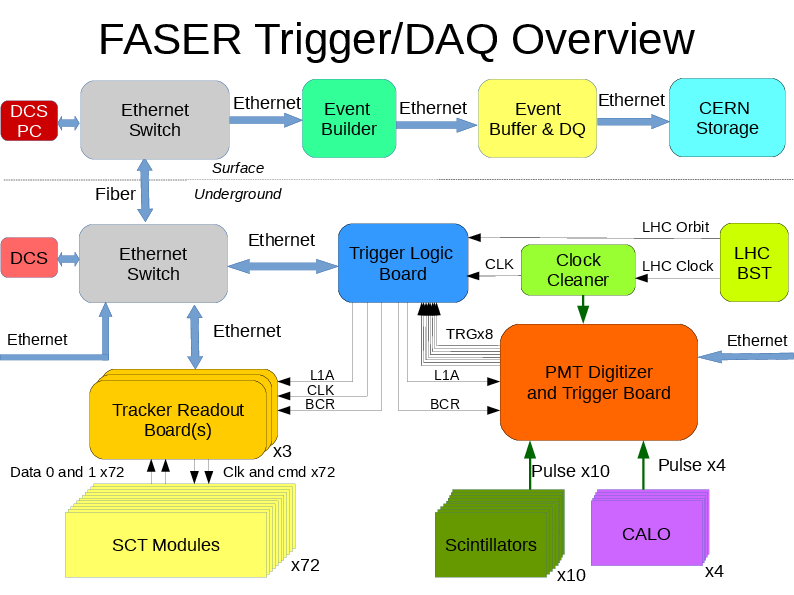
Decays of new light, long-lived particles inside FASER will trigger the detector to store information about the event in the data acquisition (DAQ) system. For redundancy and to detector efficiency measurements, all scintillator layers as well as the calorimeter provide triggering functionality. The scintillator trigger threshold is below that of a single minimum ionizing particle, while the calorimeter threshold is set at a higher level to trigger on significant electromagnetic showers.
Under the assumption that the rates are completely dominated by high-energy muons, as shown by background simulations and measurements, the expected trigger rate for different detector components can be summarized as follows:
- Veto scintillators: 360 Hz,
- Timing scintillators: 640 Hz,
- Preshower scintillators: 360 Hz,
- Calorimeter (E >100GeV): < 5 Hz.
In addition, some random triggering is expected at a level of 10 Hz. Since the rates are highly correlated, the total trigger rate is dominated by the timing scintillator, which exhibits the highest rate. The resulting total rate is expected to be around 650 Hz, which is 2-3 orders of magnitude lower than typical values in large-scale LHC experiments. The rate can be reduced further by triggering on combinations of certain (anti-)coincidences, such as a calorimeter or pre-shower scintillator signal in conjunction with the absence of a signal in the veto scintillators.
To achieve an identification of rare beyond-the-Standard-Model (BSM) physics signals, the FASER detector uses maximal information from each triggered event. For the tracker, the hit information available is limited by the pre-existing readout chip to three 25 ns-wide time bins per strip with the signal seen in the central bin. For all photomultiplier tubes (PMTs), the full waveform is read out in a much wider time window (~1 μs) to reconstruct the charge and time of each pulse accurately and to ensure the absence of anomalous activity near the time of a possible new physics signal. Basic information from the trigger system, such as the source of the trigger firing and event number is also read out. In order to measure non-collision backgrounds and minimize the system complications, the trigger signals are not restricted to be in time with the collisions at the ATLAS IP. The in-time and out-of-time event selection is performed offline instead.
A diagram of the trigger and data acquisition (TDAQ) system is shown in Fig. 1. The system has been designed to minimize the amount of equipment needed to be placed underground (where access is highly limited) while also keeping the number of signal cables entering and leaving the experiment to a minimum (as those cables need to be more than 500 m long). The trigger system runs synchronously to the LHC clock.

